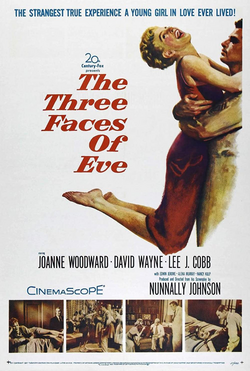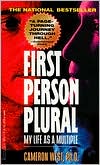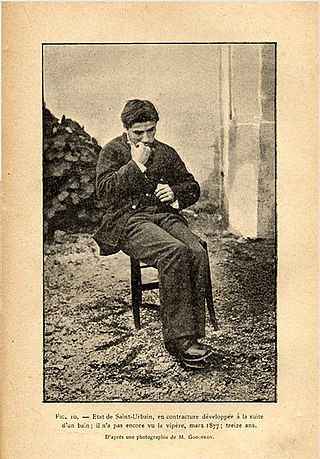
Dissociative fugue, formerly called a fugue state or psychogenic fugue, is a mental and behavioral disorder that is classified variously as a dissociative disorder, a conversion disorder, and a somatic symptom disorder. The disorder is a rare psychiatric phenomenon characterized by reversible amnesia for one's identity, including the memories, personality, and other identifying characteristics of individuality. The state can last for days, months, or longer. Dissociative fugue usually involves unplanned travel or wandering and is sometimes accompanied by the establishment of a new identity and the inability to recall personal information prior to the presentation of symptoms. It is a facet of dissociative amnesia, according to the fifth edition of the Diagnostic and Statistical Manual of Mental Disorders (DSM-5).
Dissociative identity disorder (DID), formerly known as multiple personality disorder, split personality disorder or dissociative personality disorder, is a member of the family of dissociative disorders classified by the DSM-5, DSM-5-TR, ICD-10, ICD-11, and Merck Manual for diagnosis. It remains a controversial diagnosis, despite rigorous study in the scientific literature since 1975.

The Three Faces of Eve is a 1957 American film noir mystery drama film presented in CinemaScope, based on the book of the same name about the life of Chris Costner Sizemore, which was written by psychiatrists Corbett H. Thigpen and Hervey M. Cleckley, who also helped write the screenplay. Sizemore, also known as Eve White, was a woman they suggested might have dissociative identity disorder. Sizemore's identity was concealed in interviews about this film and was not revealed to the public until 1977. The film was directed by Nunnally Johnson.
In psychology, false memory syndrome (FMS) was a controversial proposed condition in which a person's identity and relationships are affected by what are believed to be false memories of psychological trauma, recollections which are strongly believed but factually contested by the accused. Peter J. Freyd originated the term partly to explain what he said was a false accusation of sexual abuse made against him by his daughter Jennifer Freyd and his False Memory Syndrome Foundation (FMSF) subsequently popularized the concept. The principle that individuals can hold false memories and the role that outside influence can play in their formation is widely accepted by scientists, but there is debate over whether this effect can lead to the kinds of detailed memories of repeated sexual abuse and significant personality changes typical of cases that FMS has historically been applied to. However FMS has not been recognized as a psychiatric illness in any medical manuals including the ICD-10, ICD-11, or the DSM-5.
Dissociation is a concept that has been developed over time and which concerns a wide array of experiences, ranging from a mild emotional detachment from the immediate surroundings, to a more severe disconnection from physical and emotional experiences. The major characteristic of all dissociative phenomena involves a detachment from reality, rather than a loss of reality as in psychosis.

Sybil is a 1976 two-part, 3+1⁄4-hour American made-for-television film starring Sally Field and Joanne Woodward. It is based on the book of the same name, and it was broadcast on NBC on November 14–15, 1976.
Ego state therapy is a parts-based psychodynamic approach to treat various behavioural and cognitive problems within a person. It uses techniques that are common in group and family therapy, but with an individual patient, to resolve conflicts that manifest in a "family of self" within a single individual.
Christine Costner Sizemore was an American woman who, in the 1950s, was diagnosed with multiple personality disorder, now known as dissociative identity disorder. Her case, with a pseudonym used, was depicted in the 1950s book The Three Faces of Eve, written by her psychiatrists, Corbett H. Thigpen and Hervey M. Cleckley, upon which the film of the same name, starring Joanne Woodward, was based. She went public with her true identity in the 1970s.
Flora Rheta Schreiber was an American journalist and the author of the 1973 bestseller Sybil. For many years, she was also an English instructor at John Jay College of Criminal Justice.

Shirley Ardell Mason was an American art teacher who was reported to have dissociative identity disorder. Her life was purportedly described, with adaptations to protect her anonymity, in 1973 in the book Sybil, subtitled The True Story of a Woman Possessed by 16 Separate Personalities. Two films of the same name were made, one released in 1976 and the other in 2007. Both the book and the films used the name Sybil Isabel Dorsett to protect Mason's identity, though the 2007 remake stated Mason's name at its conclusion.
Cornelia B. Wilbur was an American psychiatrist. She is best known for a book, written by Flora Rheta Schreiber, and a television film, both titled Sybil, which were presented as non-fiction accounts of the psychiatric treatment she rendered to a person diagnosed with dissociative identity disorder.
Corbett H. Thigpen was an American psychiatrist and co-author of the book The Three Faces of Eve (1957).
Nicholas Peter Spanos, was professor of psychology and director of the Laboratory for Experimental Hypnosis at Carleton University from 1975 to his death in a single engine plane crash on June 6, 1994. Spanos conducted multiple studies that challenged common beliefs. He tried to distinguish the difference between common beliefs about hypnosis and what was actually occurring. These studies conducted by Spanos led to the modern understanding that hypnosis is not an altered state and is actually suggested behaviors that the participant chooses to go along with or not. Along with this, Spanos conducted studies regarding dissociative identity disorder in which he stated that multiple personalities are not a product of trauma but are based on social norms.

First Person Plural: My Life As A Multiple is a psychology-related autobiography written by Cameron West, who developed dissociative identity disorder (DID) as a result of childhood sexual abuse. In it, West describes his diagnosis, treatment, and personal experiences.

Sybil is a 2007 American made-for-television drama film directed by Joseph Sargent, and written by John Pielmeier, based on the 1973 book Sybil by Flora Rheta Schreiber, which fictionalized the story of Shirley Ardell Mason, who was diagnosed with multiple personality disorder. This is the second adaptation of the book, following the Emmy Award-winning 1976 mini-series Sybil that was broadcast by NBC. The university scenes were filmed at Dalhousie University in Nova Scotia.
Sibyls were oracular women believed to possess prophetic powers in ancient Greece.
Herbert Spiegel was an American psychiatrist who popularized therapeutic hypnosis as a mainstream medical treatment for patients experiencing pain, anxiety, and addictions. He also is known for his treatment of the woman known as Sybil, whose case became the subject of a book, 1976 television miniseries and 2007 television movie.
The International Society for the Study of Trauma and Dissociation (ISSTD) is a nonprofit professional organization of health professionals and individuals who are interested in advancing the scientific and societal understandings of trauma-based disorders, including posttraumatic stress disorder, complex posttraumatic stress disorder, and the dissociative disorders.
Multiplicity, also known as plurality or polypsychism, is the broad psychological phenomenon in which a body can feature multiple personalities. In contrast to dissociative identity disorder, the more general phenomenon of identifying as multiple is under-researched.

Louis Vivet was one of the first mental health patients to be diagnosed with dissociative identity disorder, colloquially known as "multiple [or] split personalities." Within one year of his 1885 diagnosis, the term "multiple personality" appeared in psychological literature in direct reference to Vivet.






